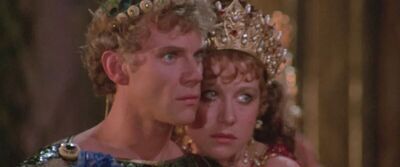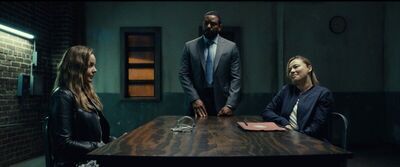

When “Caligula” arrived in theaters in 1979, it came in on a tidal wave of hype, most of it on the negative side. The production of Penthouse Magazine publisher Bob Guccione’s grand experiment in creating an adult film that included the elements innate to a typical Hollywood spectacle was filled with such strife that both screenwriter Gore Vidal and director Tinto Brass attempted to remove their names from the project. The big-name actors involved—including Malcolm McDowell, Peter O’Toole, John Gielgud, and rising star Helen Mirren—disavowed themselves from it when they discovered that, after firing Brass and taking over the editing for himself during post-production, Guccione went back to the still-standing sets with a skeleton crew and a group of Penthouse models to shoot some hardcore sex scenes. These were added into the mix without their knowledge and threatened the film with legal challenges worldwide.
The final film received universally horrible reviews — Variety described it as a “moral holocaust,” and the progenitor of this very site dubbed it “sickening, utterly worthless, shameful trash. If it is not the worst film I have ever seen, that makes it all the more shameful.” Despite, or perhaps because of, such critiques, the film would go on to be a success, especially when it arrived on the then-emerging home video market. Over the years, it has developed a cult following, to be sure, but that’s almost entirely due to a morbid fascination regarding its bizarre confluence of artistic ambitions and pornographic content. Although Guccione had discussed producing other films in the wake of “Caligula,” he never did—since one of these projects was rumored to have been about Catherine the Great, this is perhaps not that big of a loss.
And yet, what might have resulted if the film kept its initial conception? Is it possible that somewhere in the reported 96 hours of footage shot during its production lay a movie that was actually … good? These are the questions raised by “Caligula: The Ultimate Cut,” one of the oddest reclamation projects in cinema history. Producer Thomas Negovan has gone through all that footage and reconstructed an entirely new version of the film — using alternate takes and cut scenes and removing all of the hardcore footage — that hews closer to what it was intended to be. This renovation is so elaborate that, although it now clocks in at just under three hours, it does not contain a single frame of footage seen in the original version.
The result is different from what came before and is, in many instances, a marked improvement. This time around, viewers can have a better appreciation for the often-stunning costumes and production design contributions from the legendary Danilo Donati (who had worked with the likes of Zeffirelli and Fellini and who would go on to do the sets and costumes for “Flash Gordon”) that were inexplicably given short shrift the first time around. By selecting more nuanced takes instead of the over-the-top ones used before, McDowell’s performance displays more of an actual arc, making his characterization far more interesting than the flat-out loon seen the first time around. He still has plenty of moments where he struts around like a cross between Alex from “A Clockwork Orange” and Mick Jagger, but he also has moments that allow a bit of humanity to shine through.
This also has the secondary effect of allowing the work of Teresa Ann Savoy, who plays Caligula’s doomed sister/lover Drusilla (replacing the originally cast Maria Schneider, who reportedly bailed after objecting to the sexual content), not to get steamrolled in their scenes together. Although she doesn’t quite capture Drusilla’s combination of tragedy and transgression, her work here comes closer to hitting the mark. Perhaps the biggest beneficiary of this new edit is Mirren, who only appeared in the original cut for about 20 minutes but whose role is greatly expanded here and remains both the film’s best performance and the one asset that successfully embodies its artistic and prurient ambitions. (Her work also makes you wonder how much better the film might have been if she had been cast as Drusilla.)
Yet, while “Caligula: The Ultimate Cut” is a marked improvement over the previous incarnation, it still has several fundamental problems so baked in that no revision can overcome them. One of the reasons that Vidal and Brass began feuding during the production is because they had an irreconcilable disagreement regarding the depiction of Caligula and his subsequent reign of depravity — Vidal saw him as a decent person driven to madness after having absolute power bestowed upon him. In contrast, Brass saw him as a madman long before he was given his position of ultimate authority. These differences were never resolved, and as a result, the film never quite seems sure of what it is trying to say about the man and the madness that he inspired during his short reign. While the narrative has a better flow this time around, there are still many instances in which it lurches around as though important scenes are either still missing or were never filmed in the first place.
While I cannot say that I genuinely miss any of the overtly pornographic material that Guccione clumsily inserted into the original version, that stuff was, for better or worse, a key part of what made the film so notorious in the first place and discarded it entirely feels like an awkward attempt at making it all seem more tasteful, even though the project as a whole remains steadfastly removed from most accepted notions of what constitutes good taste. That said, this is not to say that this version of “Caligula” has been neutered — this is a film that still opens with Caligula in bed with his sister, takes us on a tour of an elaborate multi-level sex dungeon, and eventually finds Caligula forcing the wives of the Roman senators to work as prostitutes on an enormous landlocked ship that has been turned into a brothel to replenish the state’s depleted coffers. The equally startling levels of violence are still on display as well, including a demonstration of an elaborate decapitation machine and the still-notorious scene in which Caligula barges in on the wedding night of one of his soldiers and proceeds to rape both the bride and groom. Put it this way: this is not the kind of movie where you want to load up at the snack counter before watching it, though it does make you wonder what kind of commemorative popcorn bucket it might inspire.
In the end, despite the extensive reworking, “Caligula: The Ultimate Cut” does not reveal the film as some kind of unjustly disparaged masterpiece deserving of revaluation along the lines of once-maligned works as “Heaven’s Gate” or “Ishtar.” This is not a film for everyone by a long shot. Still, those willing to take a chance and embrace it on its own very distinct and occasionally deranged terms are likely to find themselves agreeing with the ultimate assessment of Mirren, who once described it as “an irresistible mix of art and genitals.”



